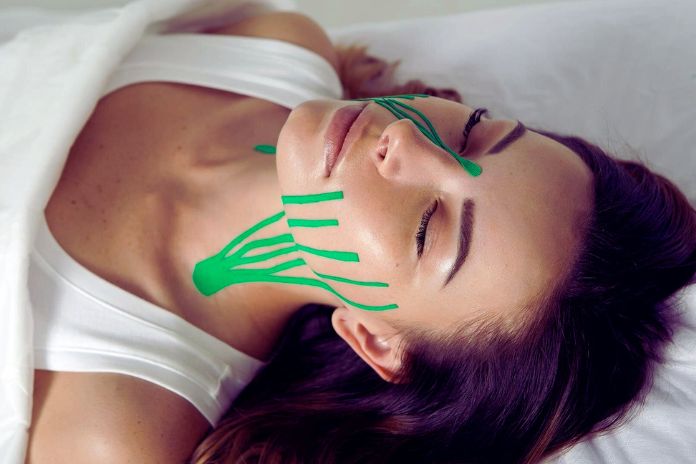Effective Help For Pain Reduction, Functional Improvement And Recovery
Athletes and elite athletes generally have been using colorful tape for years. Myo fascial taping is a gentle treatment technique to improve muscle and fascial function. Special taping techniques can positively influence tension in certain areas. At the same time, the distribution across all muscle-fascial connections throughout the body is optimized to relieve pain that has set in due to incorrect stress or inflammation.
What Is Fascia?
The body’s fascia is like a second skin in which our muscles and organs are wrapped. One speaks more often of muscle skin or connective tissue and means fascia. But why do we need this extra shell? Above all, fascia provides cushioning and protection against external forces and ensures that everything stays in place and is stable.
It is easy to imagine the fascial tissue: if you think of an orange and how you peel it, the flesh of the citrus fruit is surrounded by white, firm skin and is held together by it. Similarly, the human muscles and organs in our body are organized and held together by the fascia.
Fascia Consists Of Three Groups:
- The superficial fascial tissue is part of the subcutaneous tissue. It connects organs and tissues and lies around nerves, glands and blood vessels. It also stores fatty acids, oil and adipocytes.
- The visceral fascia is responsible for the suspension and embedding to protect the internal organs. Examples are the meninges, the pericardium or the pleura (lungs).
- The deep fascia envelops the individual muscles, muscle groups, bones and joints.
How elastic the fascia is always depends on the position and function. Deep and visceral fascia is less stretchy than superficial fascia. On the other hand, the deep fascia (high collagen content) is very resilient to tensile forces.
Pain: Sticky Fascia Is Often The Cause
If you are young and healthy, the fascia has a high elasticity and mobility. However, the elasticity decreases with age. A lack of exercise or injuries also limits function. Fascia can be injured by cuts or operations or damaged by accidents. For example, fascia can be twisted or split due to a broken bone, causing pain and restricted movement.
Fascia is also involved in sports injuries such as classic tennis elbow. No matter what causes sticky or hardened fascia, they can lead to joint pain, pain in the neck-shoulder-back area, abdominal pain or indefinable pain. Fascial taping can be an effective method to get rid of this pain.
This Is How Fascia Taping Works
Areas of application for fascia taping are primarily muscle and joint pain or swelling due to injuries or wear and tear. The taping can also be used to prevent relieving posture and tension. Pregnant women also find a treatment with kinesio tape for support, a real blessing.
With fascia taping, you exert tension on the upper layers of the skin with every movement and influence the signal quality of the receptors of the skin, muscles and fascia. This stimulates blood circulation and lymph flow and changes the tension behavior of muscles and fascia. The tissue is relieved and puts less pressure on the pain receptors. Pain is partially relieved immediately, and mobility also increases quickly.
Two Types To Apply Kinesio Tape:
- Without tension: If the Kinesio tape is applied to the skin without tension, the lymphatic vessels under the skin are stimulated. In addition, blood circulation is promoted so nutrients can get into the tissue better, and waste products and inflammatory substances are removed more quickly.
- With tension: If you want to relieve a joint or a muscle, the kinesio tape is stuck on it with tension. The tape is applied and stretched along the course of the muscle. The skin is stretched, and this stimulus is passed on to the muscle. The muscle should relax, the pain should be beneath, and mobility should increase.
The fascial tapings can or should remain on the skin for several days.
Please Note:
Kinesio taping is not a substitute for exercise therapy treatment; therefore, the discomfort’s cause must first be determined. This supportive measure is only used with treatments that include manual therapies and activating training exercises.
Also Read: Face Serum: What It Is, What It Is For And How To Use It

